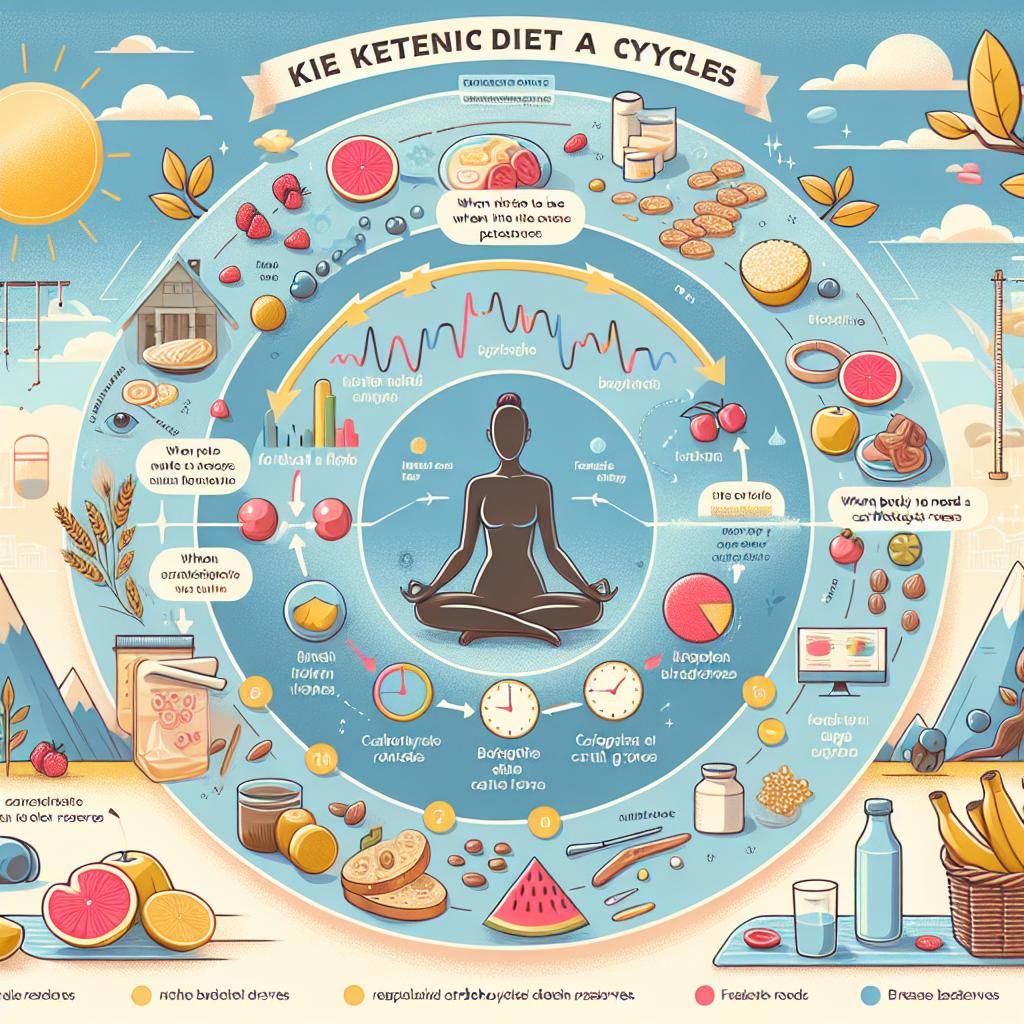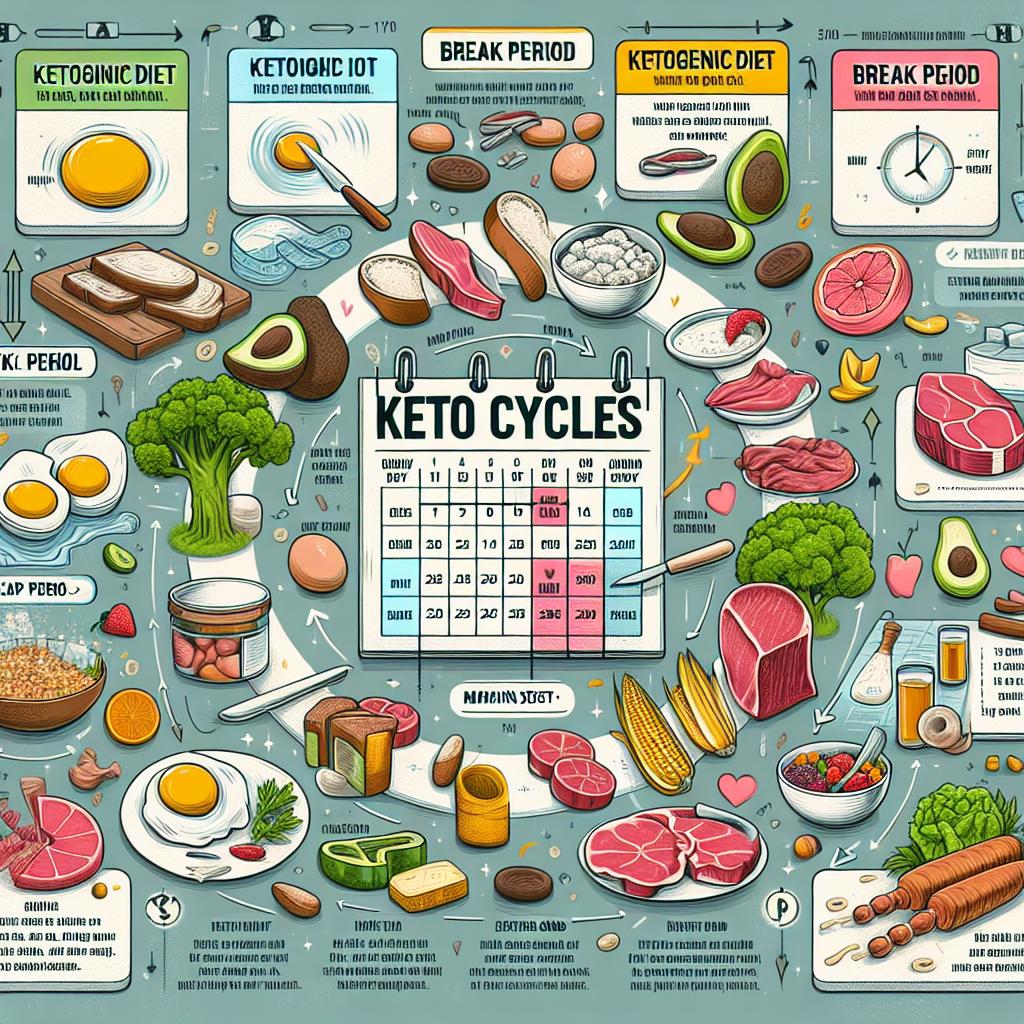This post may contain affiliate links which means I may receive a commission for purchases made through links. Learn more on my Private Policy page.
Understanding Keto Cycles: When to Take a Break
In the ever-evolving world of nutritional strategies, the ketogenic diet stands out as a popular approach, championing the benefits of low carbs and amazing fat-burning capabilities. But as with any long-term regimen, the idea of balance and sustainability becomes crucial. Enter the concept of the keto cycle! Imagine the freedom of flipping the switch between ketosis and conventional eating—embracing the benefits of both worlds without ditching your favorite treats forever. In this article, we’ll explore the ins and outs of keto cycling, helping you unravel the mysteries of this flexible lifestyle. When is it time to dive back into those carb-laden delights, and how do you keep your body thriving in the process? Let’s embark on this delicious journey together!
Navigating the Keto Journey: Finding Balance in Your Eating Patterns
Embarking on a keto journey can feel like navigating uncharted waters, but finding a harmonious rhythm in your eating patterns can make all the difference. While the primary goal might be to achieve ketosis, one shouldn’t overlook the importance of listening to your body’s cues. Incorporating cyclical keto methods, such as alternating between periods of strict ketosis and higher-carb days, can help maintain energy levels and prevent burnout. Some ways to find this balance include:
- Cycle Your Carbs: Plan specific days for higher-carb intake, especially around intense workouts.
- Maintain Variety: Introduce different keto-friendly foods to keep your meals exciting and satisfying.
- Mindful Eating: Focus on portion sizes and savor each bite to enhance your overall experience.
Taking breaks can also be pivotal for long-term success. Regularly allowing your body to reset can help you avoid plateaus and excessive cravings. Understanding when and how to break from strict ketosis doesn’t mean abandoning your goals. Instead, it involves scheduling your breaks wisely. Consider the following strategies for a successful transition:
| Break Type | Duration | Benefits |
|---|---|---|
| Short Break | 1-2 days | Reduces cravings; boosts metabolism |
| Cyclical Keto | 5 days Keto, 2 days Carb-up | Improves performance; maintains enjoyment |
| Long Break | 1 week | Allows for mental refreshment; helps reassess goals |

Signs Its Time for a Keto Break: Listening to Your Bodys Signals
Recognizing when your body is signaling it’s time to take a break from keto is key to maintaining a healthy relationship with food. Common indicators include persistent fatigue, which might suggest that your energy levels aren’t being adequately replenished, and digestive issues, such as bloating or irregular bowel movements. Additionally, if you’re experiencing hormonal fluctuations or mood swings, this could indicate that your body needs a temporary reset. It’s essential to pay attention to these signs and proactively adjust your eating habits to support your overall wellness.
Maintaining an intuitive approach to your diet means honoring the need for occasional breaks. Some more subtle cues could include a plateau in weight loss, a noticeable lack of enjoyment in meals, or even cravings for foods you’ve been avoiding. Consider embracing a balanced phase where you reintroduce moderate carbohydrates and focus on whole foods to restore bodily balance. Below is a simple table illustrating some helpful strategies to implement during your keto break:
| Strategy | Benefit |
|---|---|
| Reintroduce whole grains | Promotes gut health and boosts energy. |
| Increase fruit intake | Provides essential vitamins and satisfaction. |
| Focus on balanced meals | Enhances nutrient variety and meal satisfaction. |
Revitalizing Your Routine: The Benefits of Strategic Carb Reintroductions
After a sustained period on a ketogenic diet, it’s common to feel the desire for a change. This is where strategic carb reintroductions can play a vital role in revitalizing your routine. Temporarily adjusting your carbohydrate intake can provide numerous benefits, such as enhancing mental clarity and physical performance. By carefully selecting your reintroduction options, you can experience a renewed sense of energy and motivation while keeping your overall health goals in mind.
When planning your carb reintroduction, consider incorporating a variety of nutrient-dense sources. Choose options that not only satisfy your cravings but also provide essential vitamins and minerals. Here is a list of beneficial carbohydrate sources to consider:
- Sweet potatoes
- Quinoa
- Brown rice
- Legumes
- Fruits like berries and apples
Monitoring your body’s response is crucial during this phase. An effective way to track your progress is through a simple table that outlines your daily carbohydrate intake and its effects:
| Day | Carbs (g) | Mood | Energy Level |
|---|---|---|---|
| 1 | 50 | Good | High |
| 2 | 75 | Great | Very High |
| 3 | 100 | Tired | Medium |
By understanding your body’s responses to carbohydrates, you can tailor your approach to achieve the best results while enjoying your favorite foods once again.

Creating a Sustainable Approach: Tips for a Healthy Keto Cycle
Incorporating a sustainable approach to your keto cycle can be a game-changer for maintaining both physical health and mental well-being. As you navigate through your keto journey, consider these simple tips to ensure you’re enjoying the process while reaping the benefits:
- Focus on Whole Foods: Emphasize high-quality fats, lean proteins, and plenty of leafy greens.
- Practice Mindful Eating: Listen to your body’s hunger cues and savor each bite to foster a healthy relationship with food.
- Stay Hydrated: Drink plenty of water and consider electrolyte supplements to balance your intake, especially during a keto transition.
- Plan for Variation: Incorporating periodic breaks and varying your diet can prevent burnout and keep your metabolism engaged.
Creating a sustainable routine is about more than just food; it’s about understanding what your body needs. Here are some important aspects to consider when planning your keto cycles:
| Aspect | Considerations |
|---|---|
| Cycle Length | 4-6 weeks of strict keto followed by a 1-2 week break |
| Listening to Your Body | Watch for signs of fatigue or cravings that may signal the need for a break |
| Reintroduction Phase | Gradually reintroduce carbs to find your personal tolerance level |
Q&A
Understanding Keto Cycles: When to Take a Break
Q&A Section
Q1: What exactly is a keto cycle?
A1: Imagine your body as a finely tuned sports car – the keto cycle is like switching between regular fuel and high octane! Essentially, it involves alternating between periods of being in ketosis (high-fat, low-carb) and taking breaks where you might reintroduce some carbs. This can help your body stay adaptable and prevent some of the plateaus we sometimes hit in our fitness journeys!
Q2: Why would someone want to take a break from keto?
A2: Great question! Taking a break isn’t a sign of weakness; it’s more like giving your body a pit stop. It can help you manage cravings, improve your workouts, and even provide a mental breather. Plus, it can reignite your body’s metabolism and give you some flexibility to enjoy life, like indulging in that piece of birthday cake without guilt!
Q3: How often should I take a break from keto?
A3: Think of it like a back-and-forth dance! Many people enjoy a ‘cycle’ of about 5-6 weeks of strict keto, followed by a week or so of a more relaxed approach. But it’s all about what feels best for you! Tune into your body, observe how you respond, and adjust accordingly. Remember, dance partners need to communicate!
Q4: What foods should I include during my break?
A4: During your break, you can joyfully reintroduce some wholesome carbs! Think colorful fruits, sweet potatoes, quinoa, and whole grains. Enjoy these like you’re painting a masterpiece – vibrant and nourishing! Just be mindful; listen to your body as you reintroduce them gradually to see how you feel.
Q5: Will I gain weight during the break?
A5: It’s possible, but don’t panic! You may see a fluctuation in weight due to water retention from carbs, but this is temporary. Think of these breaks as part of your journey, not a setback. If your focus remains on overall health and progress, you’ll be well on your way!
Q6: How do I get back into ketosis after a break?
A6: Getting back into ketosis is like putting the pedal to the metal again! Start with a clean slate – focus on low-carb meals, prioritize healthy fats, and keep your protein moderate. Also, consider adding some exercise to ramp up fat burning. Patience is key; usually, you’ll hop back on that ketosis train in just a few days!
Q7: What if I feel guilty about taking a break?
A7: Guilt has no parking space here! Every hero deserves a day off, and so do you. Remember that taking breaks is a natural part of creating a sustainable lifestyle. Celebrate the balance you’re cultivating rather than worrying about fleeting moments! Life is all about enjoying the ride – one delicious carby bite at a time!
Q8: Any final tips for newbie keto cyclers?
A8: Absolutely! Be kind to yourself and remain flexible. Start with shorter breaks and see how your body and mind react. Surround yourself with supportive friends or a community (hello, keto buddies!) to share recipes and encouragement. The journey is all about you finding your rhythm. Embrace the highs and lows, and remember, every cycle can lead to growth – both in your health and your happiness!
So there you have it! Armed with this friendly knowledge, you’re ready to tackle the keto cycle like a pro. Happy cycling!
To Wrap It Up
As we wrap up our exploration of keto cycles, remember that the journey to a healthier you is a unique adventure, filled with twists and turns. Just as a scenic road trip might require pit stops to refuel and stretch your legs, so too does your body benefit from mindful breaks within your keto journey. Whether you’re in it for weight loss, increased energy, or simply a better understanding of your body’s needs, taking the time to step back can help you maintain balance and joy in your nutritional habits.
So, go ahead and embrace those breaks! Listen to your body, make adjustments when needed, and don’t forget to savor every delicious bite, whether it’s cauliflower rice or a well-earned dessert. Your path to wellness is not a sprint; it’s a marathon sprinkled with moments of indulgence and joy. Here’s to a lifestyle that is flexible, fulfilling, and fiercely your own. Happy cycling!

